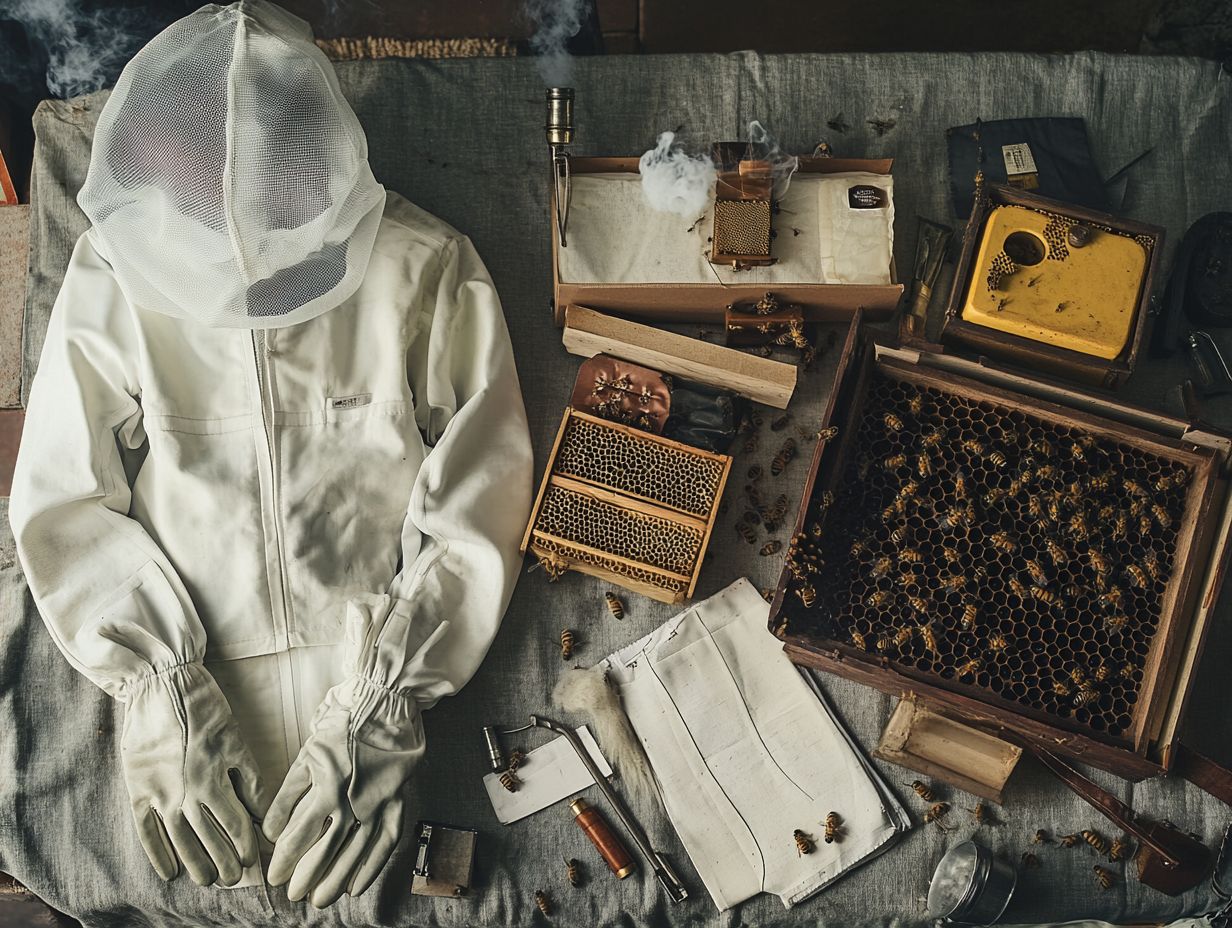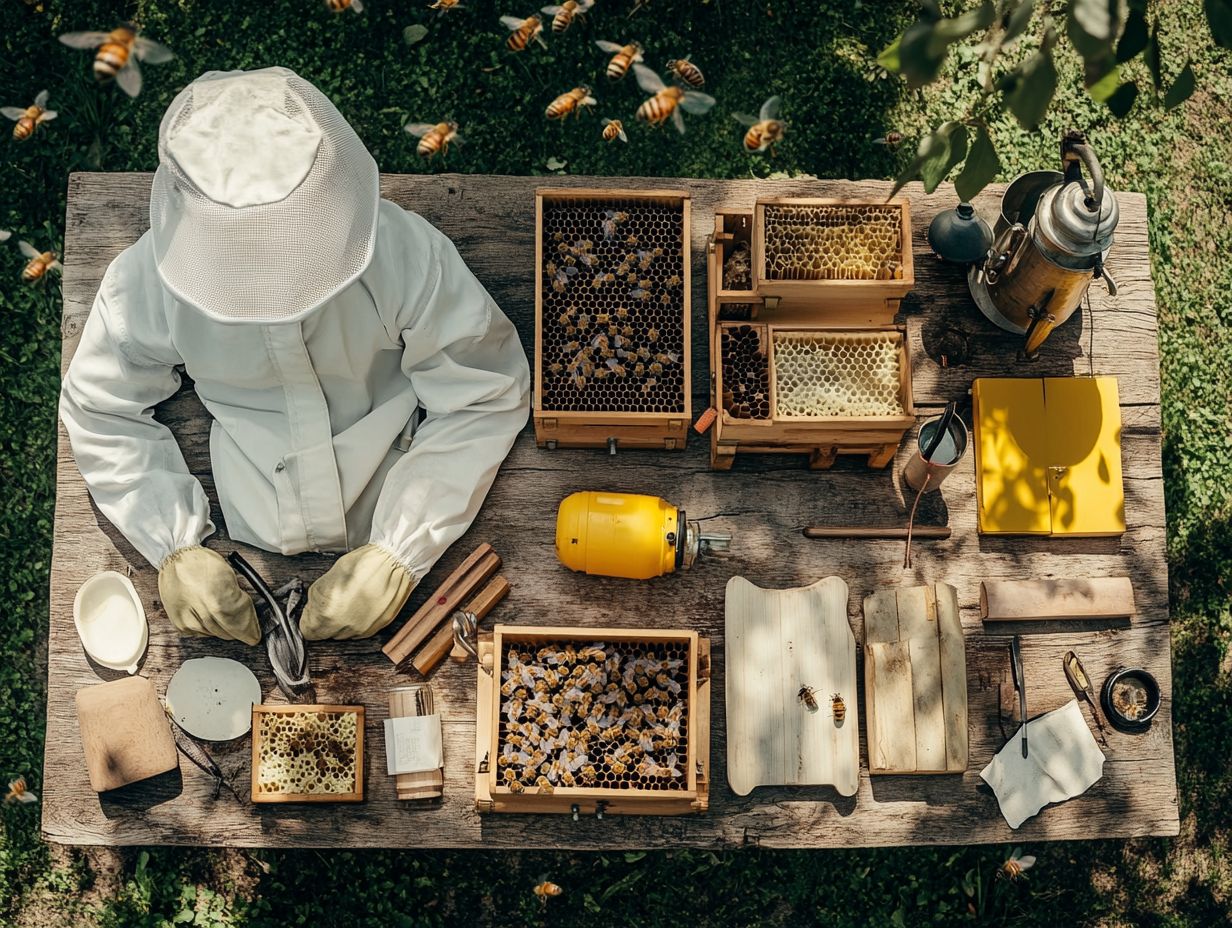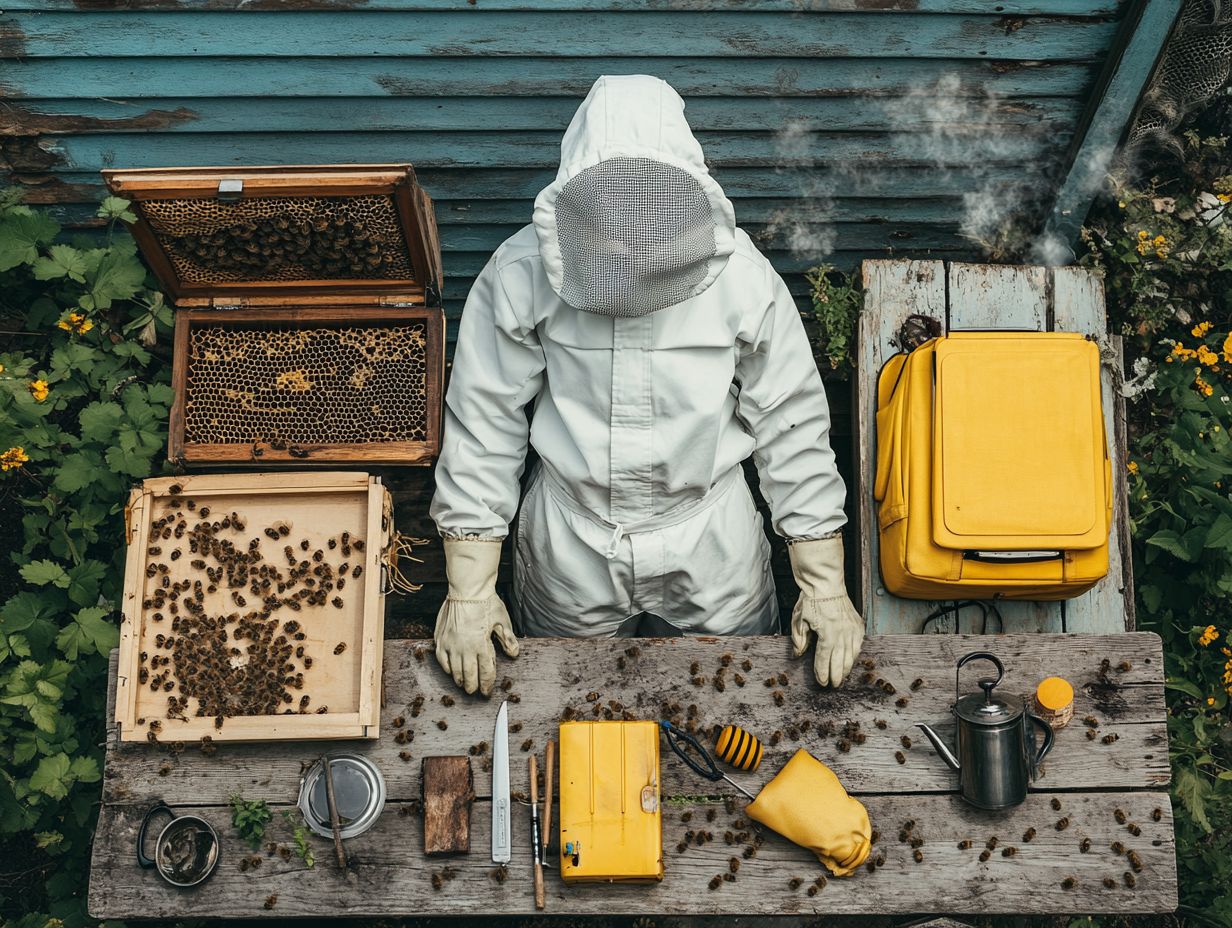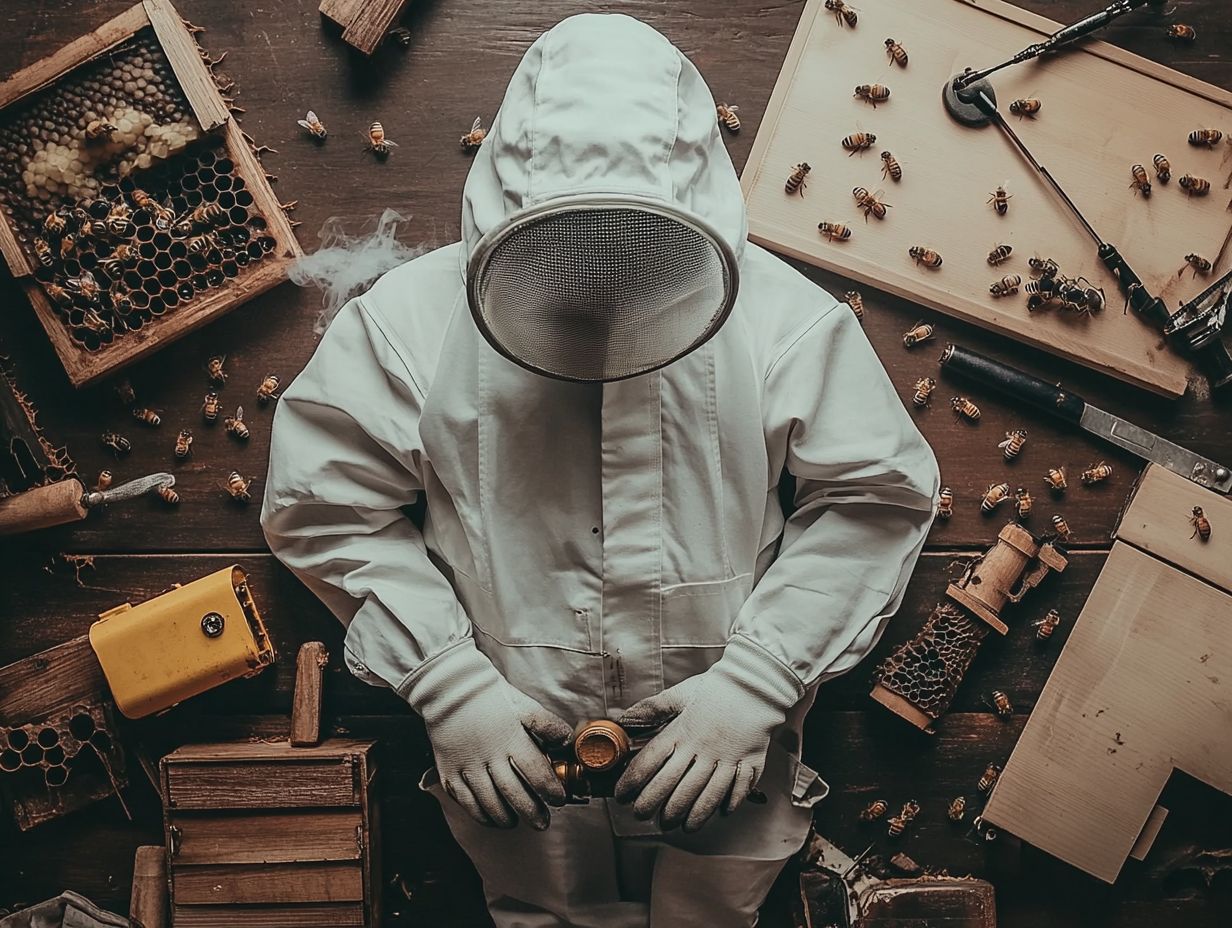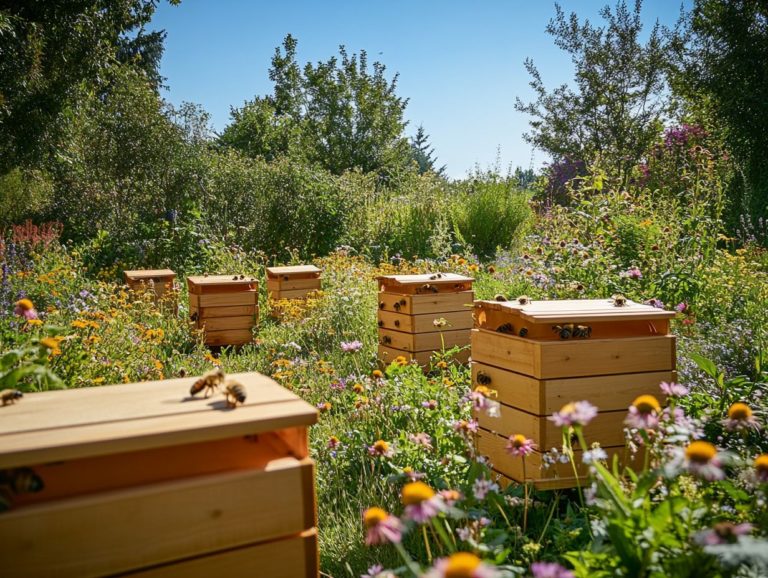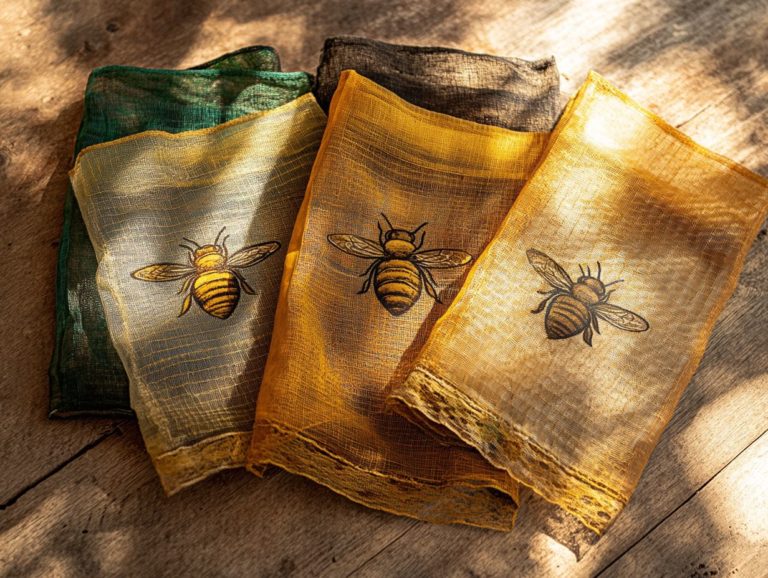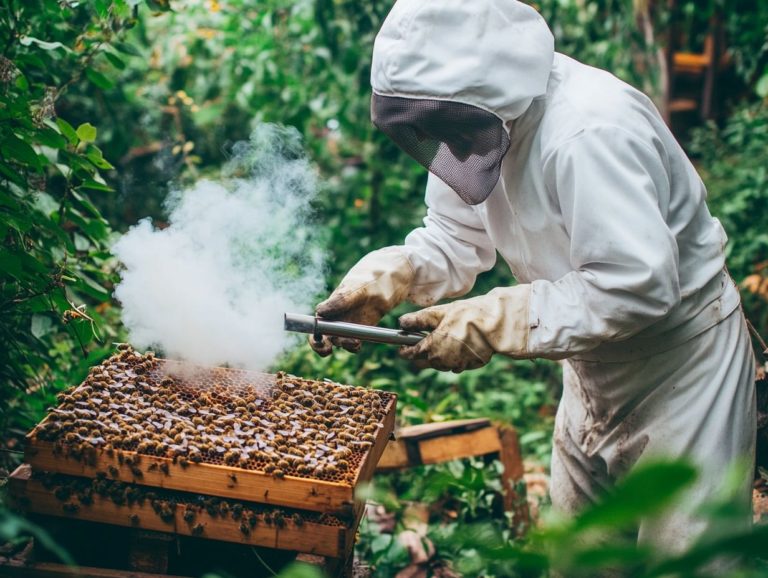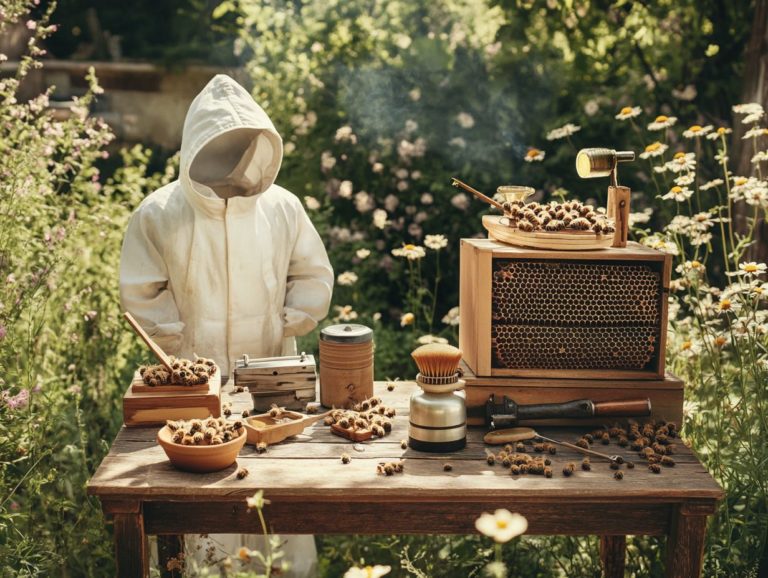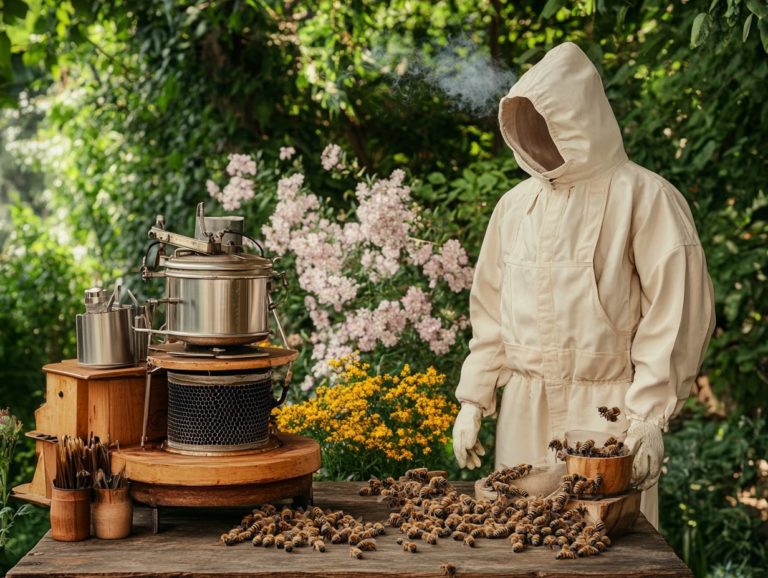Choosing the Right Beekeeping Gear for Safety
Beekeeping is rewarding. However, it comes with its own set of risks. The right gear elevates your experience and ensures your safety while you work alongside these fascinating creatures.
From protective clothing to essential tools, understanding the significance of beekeeping equipment can greatly minimize the chances of accidents.
This article will walk you through the different types of gear available. It will help you choose the right equipment tailored to your needs and guide you on where to find it.
Discover how making informed choices can profoundly impact your beekeeping journey!
Contents
- Key Takeaways:
- Why is Beekeeping Gear Important?
- Types of Beekeeping Gear
- How to Choose the Right Beekeeping Gear?
- Where to Purchase Beekeeping Gear?
- Frequently Asked Questions
- What is the importance of choosing the right beekeeping gear for safety?
- What are the essential pieces of beekeeping gear that I should have for safety?
- How should I choose the right size for my beekeeping gear?
- What are the different types of beekeeping gear available for safety?
- How often should I replace my beekeeping gear for safety?
- What safety precautions should I take when using beekeeping gear?
Key Takeaways:
- Wearing proper beekeeping gear is crucial for your safety as a beekeeper.
- Consider your comfort, quality, fit, and climate when choosing beekeeping gear.
- You can purchase beekeeping gear at local supply stores, online retailers, or secondhand markets.
Why is Beekeeping Gear Important?
Beekeeping gear is critical for you, whether you’re just starting out or have years of experience. This essential equipment provides the critical protection you need while managing your beehives effectively and sustainably.
The right gear not only ensures your safety during inspections but also helps you maintain hive health and optimize honey production. As awareness grows about the vital role bees play in pollination and maintaining ecosystem balance, embracing proper beekeeping practices with the right tools becomes increasingly essential.
Your gear will range from protective clothing to specialized hive tools. These tools are designed to assist you in the diverse tasks that come with beekeeping, ultimately setting the stage for a successful and thriving apiary.
What are the Risks of Beekeeping?
Beekeeping is rewarding. However, it has inherent risks that every beekeeper should be aware of. These risks primarily revolve around the potential for bee stings and a variety of diseases that can compromise colony health.
Understanding these dangers is essential, as they impact not only your safety but also the well-being of the bees you care for. For instance, allergic reactions to bee stings can range from mild irritations to a serious allergic reaction that demands immediate attention.
Bee diseases like American foulbrood or varroa mites are tiny parasites that can harm bee colonies severely if not managed effectively. Environmental factors, including extreme weather, pesticide exposure, and habitat loss, pose further threats to hive stability. This underscores the importance of effective hive management practices to ensure longevity and productivity.
Therefore, it’s crucial for you to remain vigilant and informed about these challenges to cultivate a thriving apiary.
How Can Beekeeping Gear Protect You?
Proper beekeeping gear, including protective clothing and specialized tools, is essential for safeguarding you from potential hazards such as bee stings and other risks associated with hive management.
This crucial equipment provides physical protection and elevates your overall beekeeping experience. It instills confidence during inspections and honey harvesting.
The right protective suit, complete with a veil, can spare you from painful encounters with the hive’s buzzing inhabitants. Your focus can remain on caring for and maintaining the bees, rather than worrying about stings.
Smokers help calm bees and reduce their defensive behavior. This further contributes to creating a safe working environment.
Hive tools, designed for various functions like prying apart frames and scraping the hive, minimize the risk of accidents. This makes hive management not just safer but also more enjoyable.
Altogether, this combination of gear prioritizes your safety and fosters a harmonious relationship with the bees.
Types of Beekeeping Gear
Understanding your beekeeping gear is not just important; it’s essential for your success and safety! The array of gear at your disposal is both diverse and vital. From fundamental protective clothing to specialized tools crafted for hive inspections and honey extraction, grasping these various types of equipment can elevate your efficiency and enhance safety during hive management.
Each piece of gear has a distinct purpose. The smoker soothes the bees, and the hive tool is designed for precise handling—both contribute significantly to the success of your beekeeping endeavors.
1. Protective Clothing
Protective clothing is an essential part of your beekeeping arsenal. It shields you from potential bee stings while allowing fluid movement during those all-important hive inspections.
A snug bee suit is your best friend! Coupled with a veil and gloves, these are critical for safely managing your bees without the constant worry of injury, enhancing your overall beekeeping experience.
Understanding the various types of protective clothing available is key for anyone venturing into beekeeping. A high-quality bee suit offers full protection, safeguarding you against stings while remaining breathable and comfortable, especially during those sweltering summer days.
Veils protect your face and neck from surprise encounters while ensuring you have an unobstructed view—critical when maneuvering around hives. Gloves are your first line of defense, so it’s essential to choose a pair that allows you the dexterity needed for effective tool handling.
Ultimately, finding gear that fits well enhances your safety and fosters a more enjoyable beekeeping experience. This makes it easier for you to concentrate on the tasks that truly matter.
2. Beekeeping Gloves
Beekeeping gloves are an essential piece of protective gear that provide necessary defense against bee stings. They also maintain the dexterity required for key hive management tasks.
These gloves come in a variety of types, including leather, rubber, and cotton. Each type offers its own unique benefits. Leather gloves are often favored for their durability and resistance to stings.
Rubber options create an excellent barrier against moisture and contaminants. Conversely, cotton gloves are lightweight and breathable, making them ideal for warmer weather.
No matter which material you choose, the right gloves not only protect you from painful stings but also enhance overall comfort. This allows you to focus better during your hive inspections.
By prioritizing protective gear, you can ensure your safety while effectively managing your bee colonies.
3. Veil or Beekeeping Hat
A beekeeping veil or hat is a critical piece of protective gear. It offers you vital visibility and protection for your face and neck, safeguarding against potential bee stings during hive inspections.
These accessories enhance your safety while also making it easier to talk to others and observe your bees. Crafted from lightweight, breathable materials, they keep you comfortable even in warm weather.
The mesh fabric allows for airflow while providing an unobstructed view. You can monitor hive conditions effortlessly without sacrificing safety. The snug fit ensures that no bees can sneak into your protective space, adding an extra layer of security against stings.
High-quality protective gear makes beekeeping safer and boosts your confidence and efficiency.
4. Smoker
A smoker is a critical tool in your beekeeping arsenal. It produces calming smoke that makes hive inspections easier.
Smokers help create a soothing environment for necessary tasks, like inspecting frames or collecting honey. The smoke triggers a natural response in bees, encouraging them to consume honey and keeping them preoccupied.
To make the most of your smoker, follow these best practices:
- Use materials like burlap or pine needles for a steady burn.
- Keep a consistent smoke output.
- Know when to apply it.
Using the smoker enhances safety and builds a better relationship with your bees.
5. Hive Tool
The hive tool is one of the most critical pieces of beekeeping equipment. It’s designed for various tasks, including prying apart hive bodies and lifting frames.
With a hive tool, you can manage your hives with precision and ease. It allows you to inspect the health of combs without disturbing the bees too much.
This tool helps you check for pests or diseases in the hive, enabling timely interventions. Its versatility streamlines your hive management and enhances the health of your bee colony.
How to Choose the Right Beekeeping Gear?
Selecting the right beekeeping gear is essential, whether you are a beginner or experienced. The gear you choose impacts your comfort, safety, and efficiency in managing your hive.
As you explore your options, think about personal comfort, equipment quality, durability, and your specific climate conditions. By understanding your needs and investing in high-quality supplies, you can boost your honey production and the health of your bees.
1. Consider Your Comfort
Comfort should be your top priority when selecting beekeeping gear. A proper fit and good mobility enhance your efficiency during hive management.
Uncomfortable gear can distract you and hinder your movements, impacting productivity. Look for breathable and lightweight materials to minimize overheating.
Well-designed suits should allow for stretch and flexibility, making tasks like inspecting hives intuitive. When your gear supports your natural movements, you can focus on creating a healthy environment for both you and your bees.
2. Look for Quality and Durability
When selecting beekeeping gear, prioritize quality and durability. These features help your gear last longer and withstand the demands of hive management over time.
High-quality equipment offers superior protection and performs exceptionally well, making it a smart choice for any committed beekeeper. Investing in durable supplies greatly influences your hive operations.
By choosing robust tools, you minimize the need for frequent replacements and repairs, ultimately saving money in the long run. Take a well-constructed smoker, for instance. It allows you to handle bees with confidence and ease!
Sturdy protective clothing provides a barrier against stings and abrasions. By focusing on quality, you not only boost your operational performance but also promote the health and productivity of your hives, creating a thriving and sustainable apiary (a place where bees are kept).
3. Check for Proper Fit
Ensuring a proper fit is essential when selecting beekeeping gear, as it directly influences your comfort and safety during hive management activities.
Ill-fitting gear can cramp your style—literally—restricting movement and heightening the risk of accidents. That’s why finding equipment tailored to your body type and working style is crucial.
When you wear well-fitted clothing and protective gear, you’ll notice a remarkable boost in mobility. This allows you to maneuver around hives effortlessly and carry out intricate tasks without a hitch.
Comfort is a game-changer too. Gear that’s too tight or too loose becomes a distraction, pulling your focus away from the bees and diminishing your overall beekeeping experience.
By investing in gear that fits just right, you shield yourself from potential stings and enhance your efficiency while tending to your colonies. This paves the way for a more productive and enjoyable time in the apiary.
4. Consider the Climate
Considering the climate is crucial when selecting the right beekeeping gear, as temperature and humidity greatly impact your comfort and the effectiveness of your equipment.
Choose gear that aligns with your local weather conditions to ensure optimal safety and functionality while managing your hives. In cooler climates, insulated suits and gloves that provide warmth yet remain flexible become essential.
This allows you to work efficiently without sacrificing comfort. Conversely, if you’re in a region with high temperatures and humidity, opting for lightweight, breathable materials is key to maintaining your body temperature and preventing overheating—especially during those long hours spent tending to your hives.
The design of bee suits, veils, and gloves can vary significantly to accommodate climatic differences. Ventilation systems in hot climates enhance airflow, while snug-fitting suits may be preferred in windy or colder areas.
Ultimately, understanding these environmental factors affects bee health and productivity, contributing to your own well-being as a beekeeper.
Where to Purchase Beekeeping Gear?
When purchasing beekeeping gear, you have many options. Local beekeeping supply stores offer personalized service, while reputable online retailers provide a wide selection to cater to your specific needs.
If you’re budget-conscious, don’t overlook the secondhand markets, which can yield excellent finds. Each purchasing avenue comes with unique benefits, making it convenient to secure the right equipment tailored just for you.
1. Local Beekeeping Supply Stores
Local beekeeping supply stores are invaluable resources for beekeepers. They provide high-quality equipment and expert support from knowledgeable staff who are often deeply involved in the beekeeping community.
Visiting these stores allows you to inspect and handle the equipment before making a purchase. This ensures that it meets your needs and enhances your understanding of the gear. Shopping at local establishments builds a strong sense of community among beekeepers. It’s a welcoming space where you can share experiences, ask questions, and receive personalized assistance tailored to your unique situation.
The knowledgeable staff often bring firsthand experience, offering insights into best practices, tips for different times of the year, and new methods. By supporting local businesses, you contribute to the local economy and reinforce the connection between beekeeping and environmental stewardship. This collaborative atmosphere enriches your learning experience and strengthens the relationships you build within the beekeeping community.
2. Online Retailers
Online retailers have become a popular choice for beekeepers, offering great convenience and a wide selection of beekeeping gear at competitive prices. You can easily compare products, read reviews, and find specialized equipment that might be hard to locate in local stores.
The freedom to explore a vast array of beekeeping supplies from home allows you to take your time choosing the finest tools and accessories for your hives. Many online platforms provide detailed descriptions and high-resolution images, ensuring you can make informed decisions before clicking “buy.”
With doorstep delivery, you can avoid the hassle of carrying bulky items from the store. Online sales often come with exclusive discounts, helping you maintain your budget while acquiring top-notch equipment. This modern shopping experience makes it quick and easy to find exactly what you need!
3. Secondhand Markets
Secondhand markets offer a great opportunity to acquire beekeeping gear without straining your budget. This makes them appealing whether you’re a hobbyist or just starting your beekeeping journey.
Shopping for used equipment not only saves you money but also champions sustainability by prolonging the life of quality beekeeping supplies. When exploring secondhand items, you might discover unique and hard-to-find tools that are not available in traditional retail outlets.
This enriches your beekeeping experience and allows you to make budget-friendly choices while embracing an eco-conscious mindset. However, it’s crucial to inspect the gear thoroughly to ensure its functionality and safety.
By exploring secondhand markets, you can cut costs while playing a part in reducing waste and supporting a circular economy. Don’t wait, explore secondhand markets today to snag great deals!
Frequently Asked Questions
What is the importance of choosing the right beekeeping gear for safety?
Choosing the right beekeeping gear is crucial for your safety. It protects you from bee stings, potential allergic reactions, and other hazards like sun exposure and extreme weather conditions.
What are the essential pieces of beekeeping gear that I should have for safety?
The most important pieces of beekeeping gear for safety include a veil, beekeeping suit or jacket, gloves, and boots. These protect your face, body, and hands from bee stings and other hazards while working with bees.
How should I choose the right size for my beekeeping gear?
When selecting beekeeping gear, it’s important to choose the right size for a comfortable fit. Make sure to try on the gear before purchasing, and consider wearing layers underneath for added protection and insulation.
What are the different types of beekeeping gear available for safety?
Beekeeping gear is essential for safety. You can choose from full suits, jackets, and smocks.
Gloves come in leather or canvas, and veils can be ventilated or non-ventilated.
How often should I replace my beekeeping gear for safety?
Your beekeeping gear can wear out, so check it regularly for rips or holes. It’s best to replace gear every 2-3 years or sooner if you notice damage.
What safety precautions should I take when using beekeeping gear?
Always smoke your bees before opening the hive. This helps keep them calm and reduces the risk of stings.
Work carefully to avoid agitating the bees. Keep a first aid kit nearby for any unexpected accidents.

